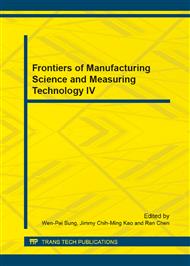p.372
p.377
p.381
p.385
p.391
p.396
p.401
p.405
p.409
Pre-Deformed Design of Optical Lenses with Reverse Engineering and Virtual Manufacturing
Abstract:
For higher geometrical accuracy requirement of optical lens, much research has been conducted either by changing the injection process parameters or changing the material of the mold or the mold manufacturing process. Although some degree of improvements was achieved, those were occasional but not-repeatable. One conventional procedure has been: the injection mold core must be polished several times to obtain qualified lens product in preproduction trial, very uneconomical and inefficient. In this paper, modern engineering tools were applied to simplify the correction process in optical lens fabrication. Combining virtual manufacturing with reverse engineering technology, the method was demonstrated very powerful. For the optical lens of 70x29.1mm in this research, the maximum deviation from the flatness after regular plastic injection molding was 0.208mm. While with combined technology of VM and RE the error was reduced to 0.008mm only by once iteration with an improvement of 96.15%. Not only the technology could be extended to larger or more challenging lens fabrication, it could also be applied to curved surfaces. This is really great tool to achieve higher quality optical lens production with much lower expending in labor and funding.
Info:
Periodical:
Pages:
391-395
Citation:
Online since:
August 2014
Authors:
Price:
Сopyright:
© 2014 Trans Tech Publications Ltd. All Rights Reserved
Share:
Citation:


